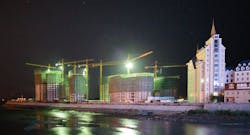Construction will outpace worldwide GDP growth over the next 15 years
Three countries—The United States, China, and India—will account for nearly three-fifths of worldwide construction growth over the next 15 years. However, their respective expansions are expected to vary markedly.
In their latest report, “Global Construction 2030,” Global Construction Perspectives and Oxford Economics estimate that annual worldwide construction activity would increase by an average of 3.9% over the next decade and a half, or one percentage point higher than the projected global GDP over that period.
The report forecasts that construction output will expand by 85% to $15.5 trillion worldwide in 2030, with the U.S., China, and India accounting for 57% of that growth. While China should remain the world’s largest construction market, its building activity is slowing and will increase “only marginally” during these years.
U.S. construction, on the other hand, is expected to grow at a 5% per year clip. America’s southern states will be the country’s construction engine over this period. And four metropolitan areas—New York, Chicago, Los Angeles, and Houston, which aggregately are home to 15% of the U.S. population—alone should account for 27% of the country’s entire construction output over this period.
Even as speculation, this report is good news for American construction workers whose industry has yet to recover fully from the last recession. Construction unemployment rate in October fell to its lowest level since 2007, according to the Bureau of Labor Statistics. But there were 6.43 million construction workers employed in the U.S. in October, compared to 7.73 million in April 2006.
Census Bureau data show that construction spending in the U.S. has been rising since February 2011—when it was just shy of an annualized $755 billion—to $1.09 trillion in September 2015. But that latest figure still falls short of the last peak, $1.213 trillion in March 2006.
Back on the world stage, India is on pace to surpass Japan as the world’s third-largest construction market by 2021, and grow at twice the rate of China through 2030, says Graham Robinson, Global Construction Perspectives’ executive director. He notes that India’s urban population over the next 15 years is expected to increase by a “staggering” 165 million, with Delhi alone adding 10.4 million people to become the world’s second-largest city.
The report sees only modest construction growth going on in Europe, which might not reach pre-recession levels again until 2025. The exception could be the United Kingdom, which the report sees overtaking Germany as the world’s sixth-largest construction market by 2030.
On the other hand, “the current weakness in most emerging countries [such as Brazil, Indonesia, and Russia] is likely to be temporary, with higher growth rates soon returning,” writes Mike Betts of Global Construction Perspectives.
The full report can be downloaded (single user license) for £1,875 ($US2,851).
